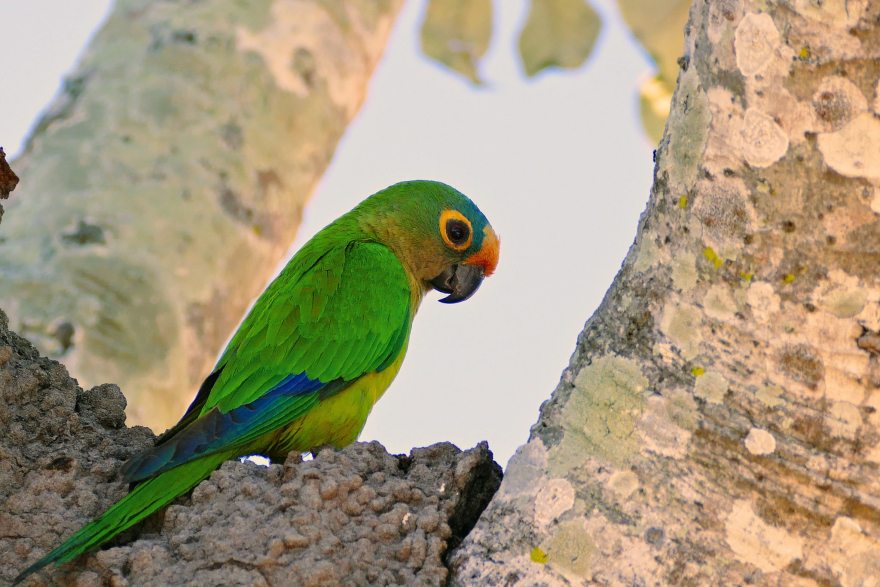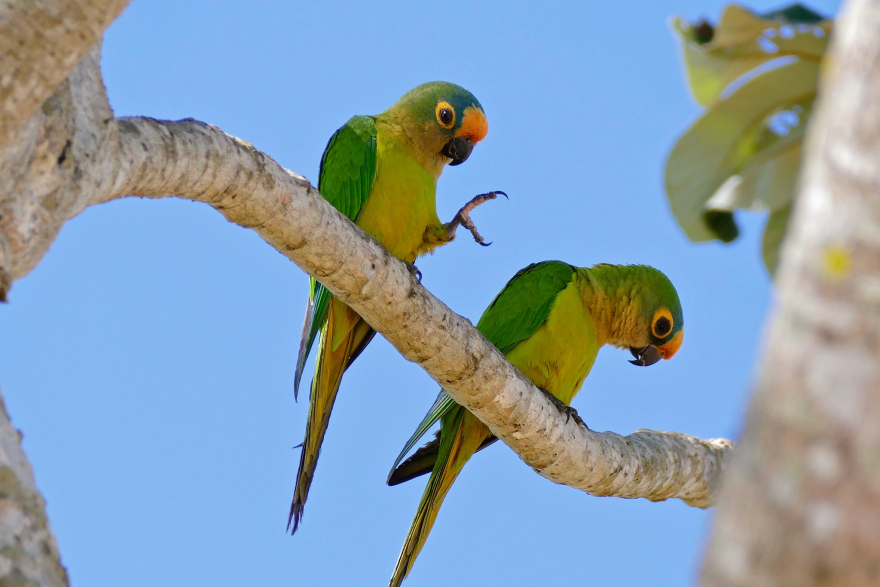The peach-fronted conure is medium-sized parrot found abundantly in central and eastern South America. They are held in Australian aviculture in fairly small numbers and can therefore demand a significant price. This species is arguably more popular as a hand-raised pet than an aviary bird.

Housing & Compatibility
Peach-fronted conures should be housed as one pair per aviary, in an aviary that’s at least three metres long. Both suspended aviaries and traditional aviaries are suitable housing options.
They should not be housed with any other species of bird due to aggression. Double wiring should be used to prevent contact between peach-fronted conures and any birds in adjoining aviaries.
Peach-fronted conures possess powerful beaks. They need to be provided with a variety of things to chew to ensure their beaks stay in good condition, including leafy branches and shelled nuts. The aviary should be fitted with natural non-toxic timber branches and perches, but be sure to replace them often.
Diet & Feeding
A quality medium parrot seed mix forms the basis of the peach-fronted conure’s diet. Seed should be stored in an airtight plastic container to prevent exposure to vermin and moisture. It can be soaked or sprouted to improve its nutritional value.
Peach-fronted conures require a wide variety of fruits, vegetables, and nuts to ensure good health. They love sweet and juicy fruits such as apple and pear, but it’s important to also provide more-nutritious green foods such as broccoli, kale, and carrot. Corn on the cob is especially enjoyed, as are peppers (chilis), berries, and natural peanuts.
Many breeders prefer to feed pellets instead of seed. Pellets provide a more balanced intake of vitamins and minerals and produce less waste. A pellet mix specifically formulated for south american parrots is best, as they typically have a higher nut content than pellet recipes designed for Australian species.

Breeding Peach-fronted Conures
Peach-fronted conures will commence breeding between late winter and early spring. Signs that they are about to breed include exploration of the nest box, an increase of timber chewing, and a sudden onset of aggressive behaviour—especially of the male towards the female.
They breed in hollow logs or nest boxes lined with sawdust or pine shavings. A medium-sized nest box that’s about a foot deep is ideal, but consider that different birds have different preferences for the size and shape of their box.
Most parrots prefer a nest box opening just large enough to squeeze through, so a separate hatch for cleaning and inspection should be added to the nest box. Different nesting receptacles should be offered to determine which the pair prefers to use. Disused boxed should be removed when laying has commenced.
Peach-fronted conures generally lay between 3 and 5 eggs. Young or inexperienced birds may lay as few as two. The hen will incubate the eggs for roughly three and half weeks. After hatching, the young birds will remain in the nest for seven weeks before fledgling. They will be fully independent from their parents approximately three weeks after fledging.
After the second or third clutch in a year, the nesting box should be removed. Over-breeding can substantially affect the health and wellbeing of the peach-fronted conure hen.
Sexing Peach-fronted Conures
Male peach-fronted conures will sometimes have more intense and larger orange patches around their eyes, however surgical or DNA sexing is required to determine a bird’s gender with a high degree of accuracy.
Peach-fronted Conure Mutations
There are no known peach-fronted conure mutations in Australia. Be wary of any supposed mutation bird, as it might be a hybrid between a peach-fronted conure and some other species in the conure family. A small number of mutations—notably a blue/white form—have been produced outside of Australia.
Health & Lifespan
A strict worm control regime and regular preventative treatment for bacterial and fungal infections is critical to ensure the long-term health of any bird.
With the proper care, a peach-fronted conure can be expected to live for 25-30 years.